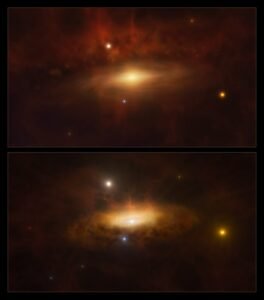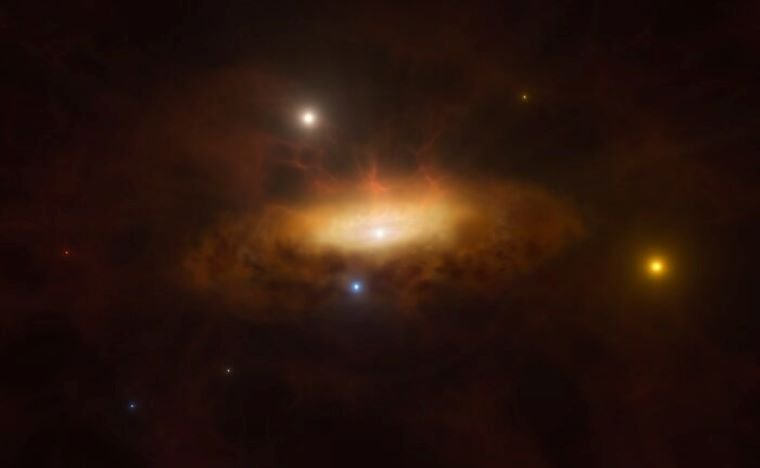Astronomers using the Zwicky Transient Facility (ZTF) telescope in the US say they have witnessed a massive black hole appear out of nowhere.
The incident occurred back in December 2019, when astronomers who were observing a distant galaxy they termed “unremarkable” suddenly began to increase in brightness rapidly.
“Imagine you’ve been observing a distant galaxy for years, and it always seemed calm and inactive,” explained Paula Sánchez Sáez, an astronomer at ESO in Germany and lead author of the study accepted for publication in Astronomy & Astrophysics. “Suddenly, its [core] starts showing dramatic changes in brightness, unlike any typical events we’ve seen before.”
Follow-up analysis by a host of the most advanced space observatories confirmed the incredible event while pointing to a likely culprit: a massive black hole lying at the heart of galaxy SDSS1335+0728, which is located 300 million light-years away in the constellation Virgo, had seemingly awakened from a long slumber and was devouring the gas in its immediate surrounding. This activity resulted in the massive and growing glow witnessed by astronomers.
Of course, people in this field regularly observe unexpected changes in the cosmos. However, events like supernova explosions or other tidal disruption events which generate large amounts of light typically last for a very short time, ranging from a few days to a few hundred days, before their brightness runs out. In this case, the researchers behind the discovery say they knew something was different when the increase in brightness first spotted in 2019 not only persisted but began to increase over time.
Since then, they have spent half a decade pouring through archived data collected by other space observatories, including the European Southern Observatory’s Very Large Telescope (ESO’s VLT), to search for an explanation. That analysis found that SDSS1335+0728 was emitting more light in the visible spectrum and ultraviolet, optical, and infrared wavelengths. Then, in February 2024, the galaxy started emitting X-rays. According to Sánchez Sáez, who is also affiliated with the Millennium Institute of Astrophysics (MAS) in Chile, such behaviour is “unprecedented.”
The team followed up on their findings by studying archival data from NASA’s Wide-field Infrared Survey Explorer (WISE) and Galaxy Evolution Explorer (GALEX), the Two Micron All Sky Survey (2MASS), the Sloan Digital Sky Survey (SDSS), and the eROSITA instrument on IKI and DLR’s Spektr-RG space observatory. That work, along with supporting data collected by the Southern Astrophysical Research Telescope (SOAR), the W. M. Keck Observatory, NASA’s Neil Gehrels Swift Observatory and the Chandra X-ray Observatory, confirmed the original findings: astronomers had indeed witnessed a black hole appear out of nowhere.
“The most tangible option to explain this phenomenon is that we are seeing how the [core] of the galaxy is beginning to show (…) activity,” says co-author Lorena Hernández García from MAS and the University of Valparaíso in Chile. “If so, this would be the first time that we see the activation of a massive black hole in real-time.”


“These giant monsters usually are sleeping and not directly visible,” added study co-author Claudio Ricci, from the Diego Portales University, also in Chile. “In the case of SDSS1335+0728, we were able to observe the awakening of the massive black hole, [which] suddenly started to feast on gas available in its surroundings, becoming very bright.”
Hernández García says this process was so rare that it had “never been observed before.” Some previous studies had reported galaxies that were thought to be inactive suddenly becoming active, but this was the first time astronomers had seen it unfolding in real-time.
While the team of astronomers admits they don’t exactly know what makes a black hole appear out of nowhere, they believe it is unlikely to be a one-time event. They even believe it could happen much closer to home, at the center of our own Milky Way galaxy.
“This is something that could happen also to our own Sgr A*, the massive black hole (…) located at the centre of our galaxy,” said Ricci.
Moving forward, the team says that additional observations and data analysis should shed even more light on their discovery. They also believe that collecting more data on SDSS1335+0728, which the Chilean-led Automatic Learning for the Rapid Classification of Events (ALeRCE) broker has classified as having an ‘active galactic nucleus’ (AGN), could benefit other researchers trying to understand the life cycle of black holes.
“Regardless of the nature of the variations, [this galaxy] provides valuable information on how black holes grow and evolve,” Sánchez Sáez said. “We expect that instruments like [MUSE on the VLT or those on the upcoming Extremely Large Telescope (ELT)] will be key in understanding [why the galaxy is brightening].”
Christopher Plain is a Science Fiction and Fantasy novelist and Head Science Writer at The Debrief. Follow and connect with him on X, learn about his books at plainfiction.com, or email him directly at christopher@thedebrief.org.

